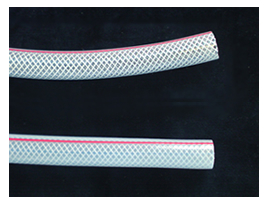Hose and Coupling Knowledge Base
If You Register to Become a Web Member, We Will Send You the Latest Information on Hoses and Coupling.
Why Transparent Hoses Become Cloudy

The hose you were using was transparent until yesterday. Today it is a cloudy white. Can you still use it? The answer is yes. During hot and humid months, transparent vinyl chloride hoses can become a cloudy white, which looks something similar to frosted glass.
The loss in transparency seen in vinyl chloride hoses is particularly common in oil-resistant hoses.
Vinyl chloride hoses are made with a plasticizer to make the hose soft. Normally, there is no room for the fluid to move between the molecules of vinyl chloride and plasticizer molecules to get into the hose material, but when the humidity rises and water evaporates, the molecules are small enough to get in. If the temperature rises further, the bonds between the vinyl chloride and plasticizer molecules begin to weaken, making it even easier for water molecules to enter.
Then, the reflection of light striking the water molecules embedded in the hose material gives the hose a cloudy appearance. The compounding ingredient used in oil-resistant hoses has large molecules, making those hoses more susceptible to this phenomenon.
Because water molecules do not bond with the other molecules, the effect is temporary. When the humidity drops, the water molecules will be pulled back out, and the hose will return to its transparent state without any effect on the quality of the hose quality.

Archive
How to Cut Steel-Wire-Reinforced PVC Hose
Does Electricity Conservation Increase Condensation?
Why Do Hoses Leak & Disconnect?
Can PVC & Other Plastic Hoses Be Used for Fuel Gas & Kerosene?
How to Read Catalog Specifications, Part 4 – Are Hose Sizes Random?
How to Read Catalog Specifications, Part 3 – Minimum Bend Radius
Beware of Static Electricity on Hoses
How to Read Catalog Specifications, Part 2 – Negative Pressure+B10
About REACH, RoHS, Endocrine Disruptor & the Food Sanitation Act
How to Read Catalog Specifications, Part 1 – Use Pressure
How to Avoid Damage Caused by Ultraviolet Rays
The Dangers of Hose Condensation
Why Transparent Hoses Become Cloudy
Leaks & Disconnections Due to Mismatched Couplings & Hoses
Causes & Solutions for Leaks & Disconnections
The Benefits of the Right Hose for the Situation (2)









